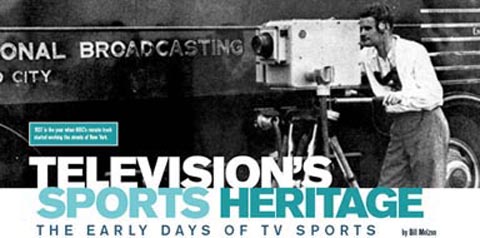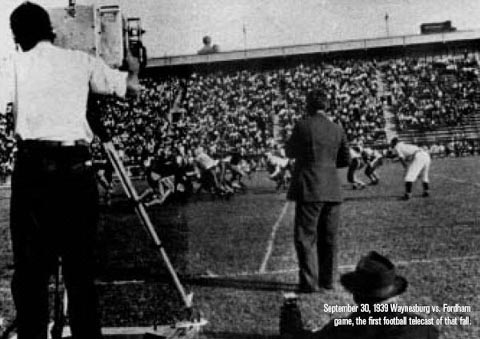|
With those words, RCA president David Sarnoff introduced the American public to television at the 1939 New York World’s Fair. NBC’s experimental noncommercial television station, W2XBS, began the first regularly scheduled TV programming in the U.S. The RCA Pavilion had a television exhibit. Visitors to it received a wallet-sized card certifying that they had been “televised.” W2XBS began field tests in 1928 as channel 1, operating with 250W (audio frequency 40.75mc, video frequency 45.25mc). Studios were later built in Radio City Music Hall. The program signal was sent by cable to RCA’s transmitter in the Empire State Building. The country’s first regularly scheduled programming, as noted in RCA’s Television’s First Year, comprised “from ten to fifteen hours a week of entertainment, enjoyment, and inspiration that has won unstinted praise from a hypercritical metropolitan audience.” The NBC producers and directors were throwing almost everything at this new medium. According to Television’s First Year, programs varied from “fulllength dramas to variety skits; from concert pianists to juggling acts.” A program called Microvivarium dealt with bacilli in a drop of drinking water. The directors and camera operators were learning that television is a close-up medium. AND NOW...SPORTS W2XBS’ sports “pick-ups” began in 1939 with the Columbia/Princeton baseball game, the Six-Day Bike Race on what the New York Daily News called the “pine saucer” in Madison Square Garden, and the IC4A Track Meet during May. June brought “televiewers” the Max Baer-Lou Nova prizefight at Yankee Stadium. The Eastern Grass Court Tennis Championships and the Cincinnati Reds playing the Brooklyn Dodgers at Ebbets Field were shown in August. As the autumn leaves turned during September 1939, so did the NBC cameras toward football. The September 30 Waynesburg College vs. Fordham University game was the first college football telecast of the fall. Waynesburg players and coaches had made the trek from the school south of Pittsburgh to play one of the nation’s college football powerhouses. October saw the Brooklyn Dodgers host the Philadelphia Eagles at Ebbets Field in the season’s first professional football game. A championship fancy-diving contest at the Manhattan Beach Pool, ice hockey, basketball, wrestling, soccer, and fencing were also televised.
Intercom equipment was new as well. The PL mic was a contraption that had a small curved horn for a mouthpiece and was worn on the chest. Just as parabs were borrowed from radio, so too were radio headsets. It really was appropriate to call them “cans” because the round metal earpieces didn’t begin to approach the quality of today’s de facto PL headset. VIEWERS? The W2XBS broadcast signal had about a 50-mile radius. It wasn’t possible for the fans in Waynesburg to see the Waynesburg- Fordham game because, according to an article in the Waynesburg College student newspaper The Yellow Jacket, “...the science of television has not been perfected to the point where the broadcast can carry any great distance.” Waynesburg is about 50 miles south of Pittsburgh, PA. So who saw the game? Estimates say there were about 1,000 sets in the New York metropolitan area that September. The RCA sets went on sale the day after Sarnoff’s April World’s Fair speech. In addition to RCA, other manufacturers included DuMont and GE. There were also hand-built kits by Andrea. While the majority of television receivers were in homes, they were also in hotels, taverns, schools, churches, and stores. TRIALS & TRIBULATIONS Those first RCA “pick-ups” were plagued by problems that still challenge EICs and crews today. On April 30, 1939, president Franklin D. Roosevelt’s opening address at the World’s Fair was telecast and marked the beginning of NBC’s regular public series of experimental programs in the New York area. When the president’s car ran over the cable extending between the television camera and the mobile unit, everyone gasped, fearing that the connection had been severed. So marked the need for cable troughs. The idea of having utilities pull camera cables probably hadn’t surfaced yet, either. Michael “Mo” Scarry, former defensive line coach for the Miami Dolphins, was one of the Waynesburg players. According to Scarry, “some of the early guys going into the game—half of them stumbled or fell over the wires going into the game.” An article in the 1940 issue of RCA’s Broadcast News introduced “vest-pocket” television field equipment, or Fly-Packs: “NBC’s television field crews were freed of limitations imposed by the necessity of finding parking space at the scene of the pick-up for the large television mobile units.” It was tough finding a truck space in New York City even back then. PROGRAMMING IS THE NECESSITY OF THE INVENTION So how did it come to pass that NBC televised the Waynesburg-Fordham game? If you were a sports producer selecting which college game would be one of the first to televise, it was a sure bet to do a Fordham game because the school was one of the nation’s football powerhouses at the time. If you were an NBC engineer doing a site survey, Fordham and N.Y.U. games were high on the list because they were the only games where it was possible to pick up by the mobile units and re-broadcast from the Empire State transmitter. Waynesburg’s Bobby Brooks entered the TV sports history book that day by running for 63 yards and scoring the first televised touchdown of the game. Of course, there was no instant replay then to see how a 153-pound back got through the Fordham line. That non-commercial telecast on Randall’s Island over 60 years ago has evolved into a multibillion dollar industry. For more information and links about early television, see our website at wctv.waynesburg.edu/earlytvsports. Thanks to those early television collectors and enthusiasts and others who Provided information, images, and help for this article: Alex Magoun, executive director of The David Sarnoff Library www.davidsarnoff.com; Steve McVoy, Early Television Foundation www.earlytelevision. org; Jeff Lendaro, Tom Genova, www.tvhistory.tv; Mike Schultz, www.uv201.com; Steve Restelli, framemaster.tripod. com; Norman J. Gagnon, www.ggninfo.com; The MZTV Museum of Television, www.mztv.com; North Callahan Jr.; James Randolph, Waynesburg College Museum curator; and Josh Starsick. Bill Molzon is the director of TV operations and an assistant professor of communication at Waynesburg College in Waynesburg, PA. He entered Waynesburg in the fall of 1969 as a freshman and never left. He can be reached at (724) 852-3270 or bmolzon@waynesburg.edu. |

